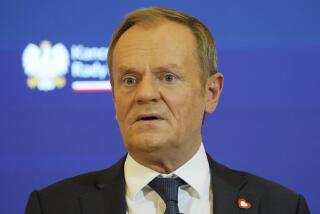Island-hopping in Eastern Europe
- Share via
Eastern Europe is opening up at a dizzying pace and nowhere more so than in Poland. Since the fall of communism in 1989, the country has been modernizing rapidly. In 2004 it joined the European Union, cementing its position at the corner of the continent. Around the same time, the budget-airline boom reached the major Polish cities, connecting them to European airports at low prices. With appetites whetted by popular destinations such as Prague, Czech Republic, and Budapest, Hungary, visitors are flocking to see what else the region has to offer. Wroclaw is a fine place to start.
Southern comfort
Tourism is a huge growth industry in Poland. Visitors mainly head for the Baltic coast and the historic port of Gdansk (Danzig), but it’s well worth venturing to the south of the country, in particular to Wroclaw, the splendid capital of the Lower Silesia province. Little known outside Poland, Wroclaw is widely considered one of the gems among the country’s many historic towns. It is a city of no fewer than 12 distinct islands, with 112 bridges connecting its various parts, and it retains a medieval charm that is enhanced by the onward march of Polish modernity.What is there to see?
Let’s start at the beginning. Like most Polish cities, Wroclaw’s focal point is its old town, the original core of the medieval town with the massive Rynek (Market Square) at its heart. The vast building in the middle of the square is the 14th century town-hall complex, an edifice so large it has three streets running through it; wander around the facade with the tour groups and assorted gawkers and you’ll quickly see why it’s known as one of the most beautiful municipal buildings in the country. The grid of streets around it also holds a beguiling mix of old and new, with everything from medieval houses to modern museums.A walker’s delight
Come dinnertime, it’s back to the Rynek, which on its own could keep you happily busy for a day. It’s lined almost solidly with bars, restaurants and cafes interspersed with the odd shop; when outdoor seating emerges in summer, the whole place fills up in a flash. Street performers and teenage break dancers provide evening eye candy, and the entire town seems to turn out for a nightly constitutional around the square, all adding to the buzz. Even in winter you’ll see constant processions of people strolling through, though they’re more likely to be ducking straight into a heated eatery than hanging around taking the air.Yes, there’s night life
If you’re an after-hours-action aficionado, you’re in luck. Wroclaw is a thriving student town, and around the Rynek it’s virtually impossible to wander more than a couple of blocks without encountering some welcoming hostelry or another. For a delicious local specialty, sample a few szarlotkas (vodka and apple juice). Meanwhile, clubs such as VuleVu at Swidnicka 53 and the Radio Bar at Rynek 48 seldom let up before dawn.Mountain retreat
Visitors to Wroclaw often combine their tour of bridges and architecture with a side trip to the nearby Sudeten Mountains, a year-round resort area with health spas. The Polish National Tourist Office offers information on this and other stops around the country at https://www.polandtour.org .Where to stay
Hotel Savoy (Plac Kooeciuszki 19, 011-48-71-340-3219, https://www.savoy.wroc.pl , doubles from $33) offers the best combination of price, location and quality and has some surprisingly large single rooms. For a bit of last-night luxury, the Hotel Dorint (ul Sw Mikoaja, 011-48-71-358-8300, doubles from $168) is the best of the many high-end options in the heart of Wroclaw.Where to eat
You don’t need to do much more than wander around the Rynek or adjacent Plac Solny to satisfy your appetite, but there are plenty of good options in the old town. Restauracja Vincent (39 ul Ruska, 011-48-71-341-0520, main courses from $10.50) has a fabulous interior, although its international cuisine is a mixed bag. At JaDka (24/25 ul Rzenicza, 011-48-71-343-6461, main courses from $5.50), chef Magda Gessler gives Polish food the gourmet treatment. For late-night carbs, Pastabar (15 ul Sw Antoniego, main courses from $1) is a good Italian haven.Getting there
From the United States, most travelers fly to Warsaw and take a one-hour domestic flight or a train (five to six hours) to Wroclaw. Airlines offering connecting flights (change of plane) from LAX include Lufthansa, Air France, KLM, British Airways and Continental. Lot Polish Airways is usually the connecting carrier on the final leg to Warsaw. From LAX, restricted round-trip fares to Warsaw begin at $779.More to Read
Sign up for The Wild
We’ll help you find the best places to hike, bike and run, as well as the perfect silent spots for meditation and yoga.
You may occasionally receive promotional content from the Los Angeles Times.






